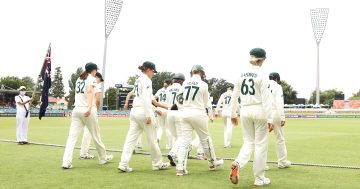
Test cricket at Manuka Oval: it’s about time Canberra scored more than scraps from Cricket Australia (but that’s a fight for another day). Photo: File.
It’s summer in Australia.
Most of the Region team is on leave and the rest of us are watching the cricket.
It’s a pleasant task: in between covering what modest news there is in the new year period, we’re also educating some young’uns on everything from the Bodyline series to Trevor Chappell’s underarm ball (with a good dose of Richie Benaud commentary memories and some long discussions about tactics).
We’re also explaining what’s good about Test cricket. Not just any cricket – not one-day cricket or that Big Bash abomination designed for nothing other than gladiatorial slashing and thumping, but real cricket. Test cricket.
Five days (if you’re really lucky) of glorious passages of play: crests, waves, troughs, the ebb and flow of a game where nothing can happen and then everything can happen at once. A game of strategy, of tactics, of emotion and history.
“Who’s winning?” asked one of the novices towards the end of Day One, expressing disbelief at the answer that we didn’t know yet.
By that stage, Pakistan had won the toss, elected to bat, folded like a house of cards in the top order, staged a fighting comeback and ended with a reasonably defendable first day’s total and a very impressive score for young Jamal.
Pat Cummins took a smashing five wickets, defying (as he has throughout his captaincy) the notion that a quick can’t lead the team.
Test cricket is operatic in its scope. It’s full of heroes and villains, including the likes of David Warner, who’s been both, and will now turn into a legend as he exits the squad. The format allows for generosity – crowds rise to their feet to applaud their opponents’ superb innings or remarkable wicket haul.
It’s called Test cricket because it’s designed to be that: a demonstration of the players’ endurance and grasp of strategy, seasoned with all the changes to the wicket, the balls, the crowd, the weather and the team’s temperament.
Will the ball begin to swing as the cloud cover comes over? Will a blistering day in Perth wipe out the Poms? How legitimate is that call for the light?
That you can play for five days and still have a nail-biting finish is one of the miracles of cricket – who could forget Steve Waugh’s 80 in the Fourth Test against India at the SCG in Sydney, where he scored the highest fourth innings score of his Test career to draw the series?
Amidst record crowd numbers, many clasping the red handkerchiefs Waugh always used to mop his forehead, ferries on the Harbour tooted their horns when the great captain reached a half-century on his final day as an Australian player.
Regrettably, we don’t see too many five-day Tests any more. Too often, it’s over in three, sometimes even in two days, although this year, the fifth day decided the Women’s Ashes Test in Trent Bridge in spectacular style.
That’s a shame. For me, the sound of summer at home, in the car (and at the office), is the murmur of commentary in the background, the roar of the crowd when something happens, and the endless debate over whether there was a snick or not.
There should be time in cricket for long cold drinks on a hot day, for cups of tea and snoozing before you check back in, for listening all the way down the coast and cursing when the signal drops out over the Clyde, and for hunching over the radio, unable to move until a truly epic game reaches its apotheosis.
No other sport in the world offers this. Long may five-day Test cricket reign.





















